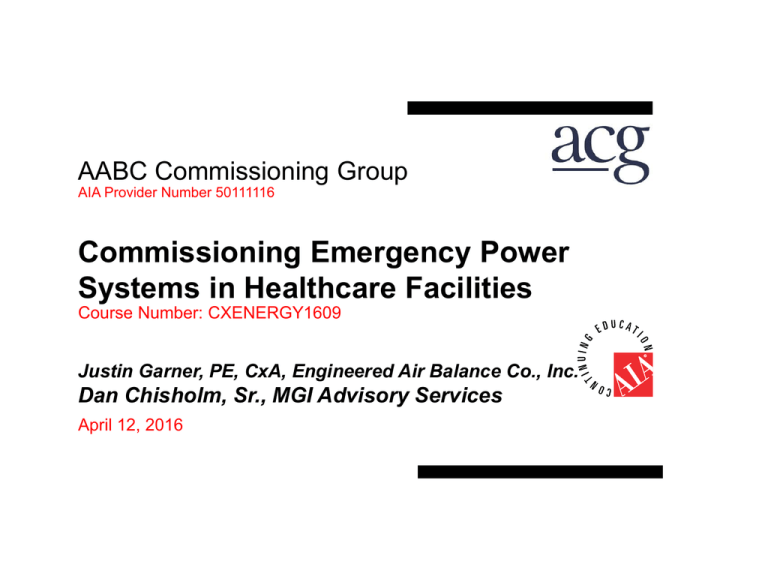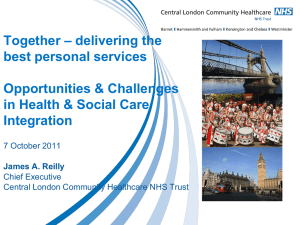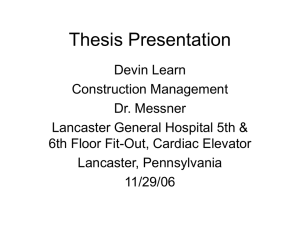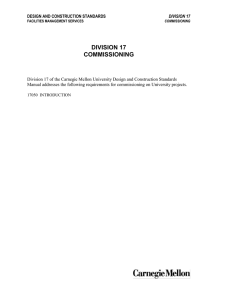Commissioning Emergency Power Systems in Healthcare Facilities
advertisement

AABC Commissioning Group AIA Provider Number 50111116 Commissioning Emergency Power Systems in Healthcare Facilities Course Number: CXENERGY1609 Justin Garner, PE, CxA, Engineered Air Balance Co., Inc. Dan Chisholm, Sr., MGI Advisory Services April 12, 2016 Credit(s) earned on completion of this course will be reported to AIA CES for AIA members. Certificates of Completion for both AIA members and non-AIA members are available upon request. CES for continuing professional education. As such, it does not include content that may be deemed or construed to be an approval or endorsement by the AIA of any material of construction or any method or manner of handling, using, distributing, or dealing in any material or product. _______________________________________ ____ Questions related to specific materials, methods, and services will be addressed at the conclusion of this presentation. This course is registered with AIA Copyright Materials This presentation is protected by US and International Copyright laws. Reproduction, distribution, display and use of the presentation without written permission of the speaker is prohibited. © Engineered Air Balance Co, Inc. 2016 © MGI Advisory Services 2016 Course Description Emergency power systems are critical to life safety codes and continuous operations in healthcare, research and mission critical facilities. This presentation focuses on the unique aspects and challenges that are present when commissioning emergency electrical power systems, both new and existing and meeting code and regulatory requirements. Learning Objectives At the end of the this course, participants will be able to: 1. Identify the prevalent codes and standards related to Emergency Power Systems in healthcare facilities. 2. Identify the systems and equipment that are critical to the operation of typical Emergency Power Systems in a healthcare facility. 3. Understand the unique Commissioning Process requirements that should be utilized when performing Commissioning of Emergency Power Systems in healthcare and critical facilities. 4. Understand best practices and regulatory requirements for operation and maintenance of Emergency Power Systems in healthcare facilities. Commissioning Emergency Power Systems in Healthcare Facilities Emergency Power Supply System (EPSS) NFPA 110 (2016) defines the EPSS as the following: A complete functioning (Emergency Power Supply) EPS system coupled to a system of conductors, disconnecting means and overcurrent protective devices, transfer switches, and all control, supervisory, and support devices up to and including the load terminals of the transfer equipment needed for the system to operate as a safe and reliable source of electric power. - National Fire Protection Association, 1 Battery March Park, Quincy, MA 02169-7471 Commissioning Emergency Power Systems in Healthcare Facilities Applicable Code Requirements 1. 2. 3. 4. 5. 6. NFPA 70: National Electric Code NFPA 99: Healthcare Facilities Code NFPA 110: Standard for Emergency and Standby Power Systems CMS Requirements Joint Commission Requirements Federal, State and Local Requirements Commissioning Emergency Power Systems in Healthcare Facilities NFPA 99 Requirements 1. Segregation of Life Safety, Critical and Equipment Branches 2. 10 second transfer times for Life Safety and Critical Branches 3. Life Safety Branch shall serve: 1. Egress illumination 2. Exit signs 3. Critical communication systems 4. EPS room lights / power 5. Elevator cab lighting and controls 6. Electrically powered egress doors 7. Fire alarm system Commissioning Emergency Power Systems in Healthcare Facilities NFPA 99 Requirements • Critical Branch shall serve 1. Critical care area illumination and power 2. Isolated power systems in special environments 3. Select illumination and power in patient care, med prep, pharmacy and nurse’s stations 4. Nurse Call Systems 5. Blood, bone and tissue banks 6. IT Rooms and Closets 7. Select illumination and power in Angiographic labs, Cardiac Cath Labs, Coronary Care Units, Hemodialysis Rooms, ER Treatment Rooms, ICU, and PACU. Commissioning Emergency Power Systems in Healthcare Facilities NFPA 99 Requirements • Equipment Branch with Delayed Automatic Transfer shall serve 1. Med Gas, Air and Vacuum Equipment 2. Sump Pumps 3. Smoke Control and Stairwell Pressurization systems 4. Kitchen Exhaust Hoods (for fire containment) 5. HVAC systems serving critical areas • Equipment Branch with Delayed Automatic OR Manual Transfer shall serve 1. Heating HVAC equipment for patient areas 2. Elevators 3. Less critical HVAC systems 4. Hyperbaric / Hypobaric facilities 5. Sterilizers Commissioning Emergency Power Systems in Healthcare Facilities NFPA 110 Requirements • Separate Room for EPS equipment with 2-hour fire rating 1. No storage or utilities permitted in the EPS room except that directly support the EPSS • EPS Alarm Annunciation (Local and Remote) for the following: 1. Low Lubricating Oil Pressure (Warning and Shutdown) 2. Low Water Temperature (Warning) 3. High Water Temperature (Warning and Shutdown) 4. Low Coolant Level (Warning) 5. Low Main Tank Fuel Level (Warning) 6. Overcrank (Shutdown) 7. Overspeed (Shutdown) 8. Battery Voltage / Charger Alarms 9. EPS not in Auto Commissioning Emergency Power Systems in Healthcare Facilities NFPA 110 Requirements • Prime Mover Starter / Battery Requirements 1. Two complete 75 second crank cycles OR 2. Two complete 45 second continuous cycles • Acceptance Testing Requirements: 1. Open utility service to facility and observe transfer to emergency source (New Facility) 2. Operate one ATS test function or open normal power breakers serving ATSs (Existing Facility) 3. Verify load acceptance / shedding sequences for paralleled EPSs 4. Record signal and transfer times to achieve steady state as designed; record electrical measurements and EPS vitals for 1.5 hours 5. Observe transfer to normal and cooldown of EPS Commissioning Emergency Power Systems in Healthcare Facilities NFPA 110 Requirements • EPS Load Testing Requirements: 1. Initiate transfer to emergency source by any means 2. Load shall be available to equal 100% of nameplate of each EPS 3. Resistive load banks are acceptable and suggested 4. Load EPS individually for 30% for 30 minutes, 50% for 30 minutes, and 100% for 60 minutes; record vitals or EPS during load test 5. EPSs in parallel can be load tested individually 6. Verify battery charge rates under operation 7. Verify all required safeties and alarming functions Commissioning Emergency Power Systems in Healthcare Facilities Typical EPSS Components 1. 2. 3. 4. 5. 6. 7. Emergency Power Source / Engine Driven Generator (Div. 26) Paralleling Switchgear (Div. 26) Automatic Transfer Switches (Div. 26) Uninterruptible Power Systems (Div. 26) Fuel Oil System (Div. 22) Equipment Room Ventilation (Div. 23) Monitoring and Alarming Systems (Div. 25) WHO IS RESPONSIBILE FOR THE ENTIRE SYSTEM? Often, it is the CxA! Commissioning Emergency Power Systems in Healthcare Facilities Typical Healthcare EPSS Commissioning Emergency Power Systems in Healthcare Facilities Emergency Power Source (EPS) 1. 2. 3. 4. 5. 6. 7. 8. Diesel or Natural Gas Engine Driven Generator Integral or remotely mounted radiator / cooling system Muffler / Catalyst system and applicable ductwork Battery Bank Overload Protection Water Jacket Heater Lube Oil Circulation Pump(s) Local Controls and Alarming Typically, the EPS will either directly feed a switching device (ATS) or be paralleled with other sources through a paralleling switchgear. Commissioning Emergency Power Systems in Healthcare Facilities Paralleling Switchgear 1. Required if multiple sources will feed a common bus 2. Main bus overcurrent protection 3. Starting, Control and Switching for EPSs 4. Distribution breakers for emergency loads (ATS or Switchgear) 5. Synchronizers / Programmable Logic Controller (PLC) 6. Load Control Sequencing 7. Monitoring / Alarming Functions 8. Manual Control Functions (Backup) 9. Typically DC powered by EPS batteries or standalone batteries 10. Connections for load bank(s) 11. Surge Suppression Equipment The Paralleling Switchgear may be supplied by the EPS vendor or independent. Commissioning Emergency Power Systems in Healthcare Facilities Automatic Transfer Switches 1. Primary switching and isolation between normal and emergency sources 2. May be standalone equipment or integrated into switchgear 3. Bypass isolation type switches facilitate easier maintenance without shutdowns to critical areas and add a measure of redundancy. 4. Controls may interface directly (serial connection) to paralleling switchgear or EPS controller if provided by the same vendor 5. Critical functions (engine start, block loading, load shed) should be hardwired signals Failure of an ATS can be catastrophic. WHAT IS THE BACKUP PLAN? Commissioning Emergency Power Systems in Healthcare Facilities Uninterruptible Power Source (UPS) 1. Battery bank with Rectifier / Inverter and Static Bypass Switch 2. Utilize for sensitive electronics (imaging equipment) and IT equipment 3. A monitored standalone maintenance bypass switch is recommended Commissioning Emergency Power Systems in Healthcare Facilities Fuel Oil System 1. 2. 3. 4. 5. 6. 7. 8. Typically includes underground or aboveground storage tanks Tank level and leakage monitoring and alarming Fill and Control Valve monitoring and alarming Circulation loop pumps (redundancy is recommended) Day Tank level controls, monitoring and alarming Day Tank High Level reports to EPS controller (NFPA 110) Typically monitored through BAS, PSMS Must be operational for sustained operation of EPSs (critical path) The Fuel Oil System vendor MUST coordinate with the EPS, Paralleling Switchgear, and BAS / PSMS vendors during the submittal phase. Commissioning Emergency Power Systems in Healthcare Facilities Ventilation Systems 1. All EPS rooms or enclosures must be ventilated for combustion air 2. EPSs with integral radiators can be utilized with roof hoods or louvers 3. Forced air fans can be utilized for large or remote rooms 4. Fans can help control temperature through BAS / T-stat integration 5. All equipment that is not integral to the EPS must be served by emergency power (including control dampers) The best EPSS in the world can fail due to a faulty control damper or fan starter relay. ALWAYS TRY TO IDENTIFY SINGLE POINTS OF FAILURE! Commissioning Emergency Power Systems in Healthcare Facilities Monitoring Systems 1. NFPA 110 mandates both local and remote / network monitoring of required alarms 2. Monitoring can be remote annunciators, BAS systems or PSMS systems 3. Protocols are typically hardwire, BACnet or Modbus 4. Critical alarming should always be hardwired 5. Remote monitoring and control is smart for redundancy and safety of personnel COORDINATION is critical for successful commissioning of monitored EPSS in healthcare facilities. Commissioning Emergency Power Systems in Healthcare Facilities CxA Responsibilties - Design Phase 1. Review OPR and BOD related to EPSS and offer comments to the design team and Owner 2. Ensure clarity of specifications and drawings related to EPSS requirements and coordination between divisions – the smallest of details matter and are easily resolved during design 3. Suggest inclusion of specific testing requirements for EPS such as factory witness testing and on-site load testing vs. code compliance 4. Question vendor sourcing preferences from Contractor if involved. 5. Do not forget about BAS / PSMS monitoring requirements 6. Try to specify one vendor (typically the P-gear / ATS vendor) to provide a coordinated set of interconnect drawings between all EPSS components COORDINATION – IT BEGINS AT DESIGN! Commissioning Emergency Power Systems in Healthcare Facilities LESSON LEARNED The insulation requirements for the EPS muffler were overlooked in the specification by the design team. The insulation that was installed caught fire during the load testing. Commissioning Emergency Power Systems in Healthcare Facilities CxA Responsibilities – Pre-Construction Phase 1. Assist Design Team, Owner and Contractor with review of vendor proposals to evaluate compatibility, coordination and Owner’s requirements (may vary slightly from vendor to vendor) 2. Assist the Owner with value engineering exercises to ensure that the EPSS components will meet the OPR and BOD. 3. Factory Witness Testing is suggested for all EPSs, Paralleling Switchgear, and UPSs 4. Assist the Owner to evaluate vendor specific options that assist with Operations and Maintenance (ie. fuel filtering, load bank cabinets) Don’t let a good design be VE’d into a serious problem! Commissioning Emergency Power Systems in Healthcare Facilities CxA Responsibilities – Early Construction Phase 1. Thoroughly review equipment submittals in parallel with the Design Team; look at the entire system for coordination when evaluating each individual submittal 2. Attend Contractor submittal and coordination reviews related to the EPSS; often the CxA is the only one that looks at the entire system as a whole 3. Attend Factory Witness Testing and ask coordination related questions; be familiar with installation requirements – factory changes are easier than field changes Last chance to catch problems before they cost a lot more money to resolve! Commissioning Emergency Power Systems in Healthcare Facilities CxA Responsibilities – Construction Phase 1. Provide site observation during installation of equipment – ensure that EPSS components are protected while rough construction is completed; equipment damage may not be evident until the schedule is critical 2. Attend underground installation activities that may happen during offhours 3. Attend the Contractor’s pre-installation meeting for the EPSS components; have testing procedures written for review during the meeting COORDINATION, COORDINATION, COORDINATION! Commissioning Emergency Power Systems in Healthcare Facilities FIELD OBSERVATION Pressure testing / inspection of underground fuel oil tanks prior to setting in the ground It is a lot easier to fix a leak when the tanks are above ground! Commissioning Emergency Power Systems in Healthcare Facilities FIELD OBSERVATION Witness torqueing of mechanical fasteners for major electrical connections. A loose connection at best will be found during a thermal scan (way too late) or at worst can cause a catastrophic failure that could injure personnel and delay the project. Commissioning Emergency Power Systems in Healthcare Facilities CxA Responsibilities – Construction Phase (cont.) 4. Assist the Contractor and subs with completion of System Verification Checklists; coordinate required supporting documentation 5. Ensure all NETA Acceptance Testing is completed (if required) prior to energizing any power equipment 6. Attend equipment startups – this is usually a good time to check alarming coordination 7. Attend load bank testing of EPSs and UPSs if separate from functional performance testing SAFETY IS KEY WITH ELECTRICAL AND ROTATING EQUIPMENT! Commissioning Emergency Power Systems in Healthcare Facilities FIELD OBSERVATION Resistive load banks and an external connection cabinet are very helpful for testing EPSS components. The building load may not be sufficient during construction to effectively test the EPSS. Commissioning Emergency Power Systems in Healthcare Facilities CxA Responsibilities – Acceptance Phase • EPSS Functional Performance Testing Sequence 1. Fuel Oil System – ensure pumping, level controls and alarming are operational 2. EPS Room Ventilation – ensure activation when EPS is operating 3. EPS Testing – Verify all required alarming both locally and remote; perform required load bank testing 4. Paralleling Switchgear - Verify all sequences, alarming, load acceptance and shedding 5. Automatic Transfer Switches – Verify all sequences, bypass, isolation and alarming under building load 6. Uninterruptible Power Sources – Verify all sequences, alarming, static switches and maintenance bypass Commissioning Emergency Power Systems in Healthcare Facilities CxA Responsibilities – Acceptance Phase • Integrated Systems Testing 1. Normal Operation– Document status of all systems on normal power under normal operation 2. Transfer to Emergency – Disconnect normal power to the building and observe the EPSS system operate in automatic to restore critical power 3. Emergency Power Verification– Verify life safety lighting, fire alarm sequences under emergency power, and operation of critical HVAC and plumbing systems 4. Failure Scenarios – Verify systems with redundancy by intentionally failing components and observing recovery 5. Return to Normal Power – Verify transfer of EPSS back to normal power for stability and continuity of service during transfer Often the BIGGEST PROBLEMS are noted when RETURNING to Normal Power! Commissioning Emergency Power Systems in Healthcare Facilities CxA Responsibilities – Occupancy Phase • Owner Training 1. Observe and contribute to Owner Training Activities 2. Often the CxA understands the ENTIRE system better than individual vendors 3. Ensure the O&M information meets the specification and is used during the training sessions 4. Ensure the training includes both classroom time and field training The best EPSS is destined for failure in the hands of inexperienced O&M Personnel! Commissioning Emergency Power Systems in Healthcare Facilities Operations and Maintenance of EPSS • Periodic and Annual Testing 1. Generators should be operated monthly and load bank tested annually 2. ATSs should be transferred monthly utilizing test switches 3. 10 second transfer requirements should be verified on all life safety and critical branch ATSs annually 4. Infrared inspections and termination torque verification should occur annually. 5. Circuit breakers should be inspected and injection tested every two years. 6. Entire EPSS system should be operated for minimum of 4 hours continuously every three years (Tri-Annual Testing) Commissioning Emergency Power Systems in Healthcare Facilities Operations and Maintenance of EPSS • Risk Analysis 1. Generators/Engines rarely fail, it’s the other components batteries, fuel supply systems, rubber, etc. How are they connected, and are there “next level redundancies” in place? 2. Age, Parts Availability, SPOOFs, Needed Repairs and Location Issues? 3. Laboratory analysis of all fluids. Do you know the parameters and what the analysis predicts? PdM protocols in place? 4. The CxA should ensure that baseline data is transmitted to the Owner to use in the initial risk analysis of a new facility. The best EPSS is destined for failure if not properly maintained! Commissioning Emergency Power Systems in Healthcare Facilities Operations and Maintenance of EPSS • Predictive Maintenance (PdM) 1. Batteries – Specific Gravity or CCA is a PdM Tool; NFPA 110 Appendix suggests replacement between 24-30 months…whether they’ve failed or not! 2. Fuel Management – Fuel Analysis standard added to NFPA 110; ASTM D975 is very expensive 3. Laboratory analysis of all fluids – Coolant and Lubricating Oil Testing; how often are fluids changed? Is an SOP in place to ensure continuity of service during maintenance activities / outages? A CUTOVER PLAN is CRITICAL! Commissioning Emergency Power Systems in Healthcare Facilities Operations and Maintenance of EPSS • NFPA 110 -2016 Record Keeping Requirements 8.5.1 Records shall be created and maintained for all EPSS inspections, operational tests, exercise repairs, and modifications. 8.5.2 Records required in 8.5.1 shall be made available to the authority having jurisdiction on request. 8.5.3 The record shall include: (1) The data of the maintenance report (2) Identification of the servicing personnel (3) Notation of any unsatisfactory condition and the corrective action taken, including parts replaced (4) Testing of any repair in the time recommended by the manufacturer 8.5.4 Record shall be maintained for a period of time defined by the facility management or by the authority having jurisdiction. Commissioning Emergency Power Systems in Healthcare Facilities Operations and Maintenance of EPSS • Island Exercise 1. 2. 3. 4. Total loss of outside services: water, fuel, power, repair services and communication (See NFPA 110 for paragraph on spare parts.) Your options, and their options: Leave or Defend-in-Place? For how long? Questions to ask service providers: Do you have a generator that will enable you to extend services; what is your fuel burn in hours at max load; how are you maintaining it; can I see your service records? What is your Plan B in case their Plan B tanks, and how often is it rehearsed? How can the CxA assist the Owner with this analysis? Commissioning Emergency Power Systems in Healthcare Facilities Operations and Maintenance of EPSS • Emergency Power Command Center (EPCC) 1. 2. 3. 4. 5. Document Storage Report Review and Plan Development Dynamic Action Plans Knowledge Transfer Surveyor Portal Commissioning Emergency Power Systems in Healthcare Facilities Hurricane Sandy Patient Evacuation DON’T LET THIS HAPPEN TO ONE OF YOUR CLIENTS! This concludes The American Institute of Architects Continuing Education Systems Course Justin F. Garner, P.E., CxA 281-873-7084 jgarner@eabcoinc.com Dan Chisholm, Sr. 407-421-7189 Dan.Chisholm@mgi-epss.com




